
Banksia catoglypta is a species of shrub that is endemic to Western Australia. It has pinnatisect leaves with sharply-pointed, triangular lobes and heads of golden brown and cream-coloured flowers.
Banksia lepidorhiza is a species of prostrate shrub that is endemic to Western Australia. It has underground stems, linear pinnatipartite leaves with sharply pointed lobes, pink, cream-coloured and yellow flowers in head of about thirty and egg-shaped follicles. It is only known from near Woodanilling.

Banksia dallanneyi, commonly known as couch honeypot, is a species of prostrate shrub that is endemic to Western Australia. It only has a short above-ground stem, pinnatipartite or pinnatisect leaves, between thirty and seventy variously coloured flowers and glabrous, egg-shaped fruit.

Cleomella plocasperma is a species of flowering plant in the cleome family known by the common name twisted cleomella and alkali stinkweed. It is native to the Great Basin and Mojave Desert in the western United States, where it grows mainly in wet, alkaline soils such as those around hot springs. There is a disjunct population in the Bruneau Valley of southwestern Idaho. It grows with other halophytic species such as saltgrass and greasewood. This is an annual herb producing a smooth, hairless stem which divides into several erect or upright branches which may exceed half a meter tall. The sparse leaves are each split into three narrow leaflets. The flowers occur in a raceme at the top of each stem branch. Each flower has four yellow petals and several long stamens which may be over a centimeter long. The fruit is a capsule with large lobes. It hangs at the tip of the remaining flower receptacle.
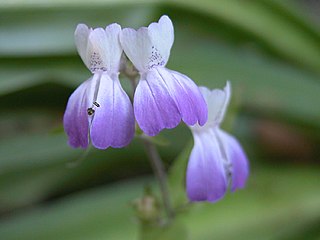
Collinsia multicolor is a species of flowering plant in the plantain family, known by the common names San Francisco blue eyed Mary and San Francisco collinsia. It is endemic to the San Francisco Bay Area, where it is known from San Francisco to Santa Cruz. As of 2008 there are 22 known occurrences. Populations south of Santa Cruz have been extirpated.

Collomia heterophylla is a species of flowering plant in the phlox family known by the common name variableleaf collomia. It is native to western North America from British Columbia to Idaho to central California, where it grows in several types of habitat, including open areas on gravelly mountain slopes. It is a hairy annual herb producing a branching, erect stem. As the common name suggests, the leaves are variable in shape, the lower generally with several toothed lobes and the upper sometimes lacking lobes. The inflorescence is a cluster of flowers emerging from the top of the stem or from the axil of a leaf. It may bear up to 25 flowers, each with star-shaped corolla at the tip of an elongated tube. The corolla lobes are lance-shaped and white to deep pink with white bases.
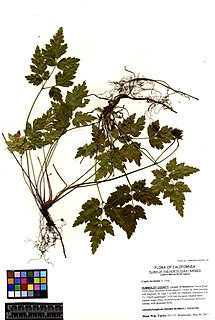
Coptis laciniata is a species of flowering plant in the buttercup family known by the common name Oregon goldthread. It is native to Washington, Oregon, and northern California on the west coast of the United States, where it grows in wet habitat in the understory of mountain and coastal coniferous forests. It is a small perennial herb creeping on a yellow stolon through other vegetation and leaf litter. There are a few leaves on its short stem which are divided into leaflets subdivided into several toothed lobes. The stemlike inflorescence arises up to 19 centimeters tall from the stem at ground level. Each flower is an array of thin, threadlike petals. Six to 12 fruits arise on short stalks, arranged in a ring. The fruits are shiny, hairless follicles, each roughly a centimeter long.

Lithophragma affine is a species of flowering plant in the saxifrage family known by the common name San Francisco woodland star. It is native to the coast of western North America from Oregon to Baja California, where it grows in open habitat on mountain slopes, hills, and canyonsides. It is a rhizomatous perennial herb growing erect or leaning with a tall naked flowering stem. The leaves are located on the lower part of the stem, each divided into sharp-pointed lobes. The stem bears up to 15 widely spaced flowers, each in a cuplike calyx of red or green sepals. The five petals are bright white, up to 1.3 centimeters long, and divided into three toothlike lobes at the tips.
Lithophragma bolanderi is a species of flowering plant in the saxifrage family known by the common name Bolander's woodland star. It is endemic to California, where it is known from several mountain ranges, including the North Coast Ranges, the foothills of the Sierra Nevada, and the San Gabriel Mountains. It grows in many types of open habitat. It is a rhizomatous perennial herb growing erect or leaning with a tall naked flowering stem. The leaves are located on the lower part of the stem, each divided into rounded lobes. The stem bears up to 25 flowers, each in a cuplike calyx of red or green sepals. The five petals are white, under one centimeter long, and toothed or smooth along the edges.
Lithophragma campanulatum is a species of flowering plant in the saxifrage family known by the common name Siskiyou Mountain woodland star. It is native to southern Oregon and northern California, where it grows in the forests and woods of the mountains. It is a rhizomatous perennial herb growing erect or leaning with a tall naked flowering stem. The leaves are mostly located on the lower part of the stem, each divided into rounded lobes, sometimes narrowed into teeth. The stem bears 2 to 11 flowers, each in a cuplike calyx of red or green sepals. The five petals are white, under one centimeter long, and divided into irregular toothlike lobes.
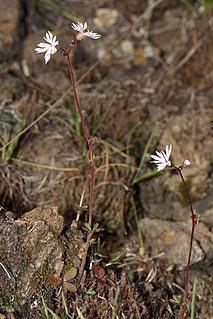
Lithophragma glabrum is a slender perennial western North American mountain plant in the Saxifrage family (Saxifragaceae), known by the common names bulbous woodland star, bulbiferous prairie-star, smooth woodland star, and smooth rockstar.
Lithophragma heterophyllum is a species of flowering plant in the saxifrage family known by the common name hillside woodland star. It is native to the coastal mountain ranges of California, where it can generally be found in shady habitat. It is a rhizomatous perennial herb growing erect or leaning with a slender naked flowering stem. The leaves are located on the lower part of the stem, each divided into rounded lobes. The stem bears 3 to 12 flowers, each in a cuplike calyx of red or green sepals. The five petals are white, up to 1.2 centimeters long, and usually divided into about three pointed lobes.

Lithophragma parviflorum is a species of flowering plant in the saxifrage family known by the common name smallflower woodland star. It is native to much of western North America from British Columbia to California to South Dakota and Nebraska, where it grows in several types of open habitat. It is a rhizomatous perennial herb growing erect or leaning with a naked flowering stem. The leaves are mainly located low on the stem, each cut into three lobes or divided into three lobed leaflets. The stem bears up to 14 flowers, each in a cuplike calyx of red or green sepals. The five petals are bright white, up to 1.6 centimeters long, and usually divided into three toothlike lobes.

Plectorrhiza, commonly known as tangle orchids, is a genus of three species of flowering plants from the orchid family, Orchidaceae and is endemic to Australia. Orchids in the genus Plectorrhiza are epiphytic or lithophytic herbs with short stems, long, tangled roots, short leathery leaves and small flowers on a short, thin flowering stem. Two species occur in eastern Australia and one is endemic to Lord Howe Island.
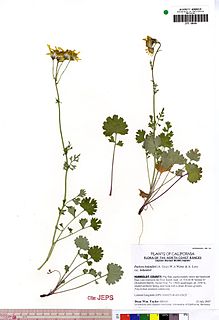
Packera bolanderi is a species of flowering plant in the aster family known by the common names Bolander's ragwort and seacoast ragwort. It is native to the west coast of the United States from Washington to northern California, where it grows in wet coastal forests and woodlands. There are two varieties of the species which differ slightly in morphology and habitat occupied; these varieties have been considered separate species by some authors. The var. bolanderi has thicker leaves, occurs farther south, and occupies more open types of habitat, than does var. harfordii. This plant in general is a perennial herb producing one to three stems up to half a meter tall. The basal leaves have blades up to 12 centimeters long which are divided into several lobes and borne on long, thin petioles. Leaves growing farther up the stem are smaller and have more lobes on their blades. The inflorescence contains several flower heads, each lined with dark green phyllaries. The head contains many golden yellow disc florets and generally either 8 or 13 yellow ray florets each over a centimeter long. The fruit is an achene tipped with a pappus of bristles.
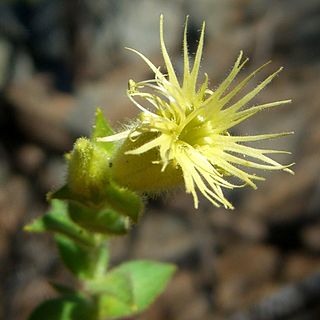
Silene parishii is a species of flowering plant in the family Caryophyllaceae known by the common name Parish's catchfly. It is endemic to southern California, where it is known from several of the local mountain ranges, including the San Bernardino, San Gabriel, and San Jacinto Mountains. It grows in rocky, forested habitat, sometimes in the alpine climates of the higher peaks. It is a perennial herb growing from a woody, branching caudex and taproot, sending up several decumbent or erect stems 10 to 40 centimetres tall. The oppositely arranged leaves line the stems, the largest ones located at the middle of each stem. Leaves are lance-shaped to nearly oval and up to 6 centimetres long. They are thick and leathery, and sometimes glandular and sticky. Each flower is encapsulated in a tubular calyx of fused sepals which may be nearly 3 centimetres long. It is greenish with ten veins and a coating of glandular hairs. The five petals are yellowish in colour and each has about six long, fringelike lobes at the tip.
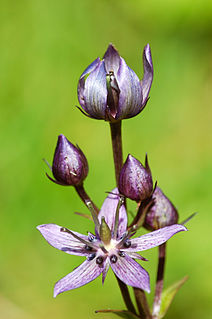
Swertia perennis is a species of flowering plant in the gentian family known by the common names felwort and star swertia. It is native to several regions of the northern hemisphere, including much of Eurasia and western North America. It is a plant of wetlands, particularly calcareous fens. It is common to abundant in many areas, but it is known to be negatively impacted by habitat fragmentation and other habitat destruction, and human activity has led to its extirpation from some areas where it was once common. It is a perennial herb producing usually one erect stem growing 10 to 50 centimeters tall. The basal leaves are spoon-shaped with rounded tips, and leaves higher on the plant are widely lance-shaped or somewhat oval, with pointed tips. The inflorescence is an open panicle of flowers atop the stem. Each flower has a calyx of four or five pointed sepals and a corolla of four or five pointed lobes each up to 1.3 centimeters long. The corolla is dull blue to violet in color with darker purplish veining or stippling. There are two rounded nectary pits at the base of each lobe of the corolla. Stamens tipped with large anthers surround a central ovary.
Frasera puberulenta is a species of flowering plant in the gentian family known by the common name Inyo frasera.
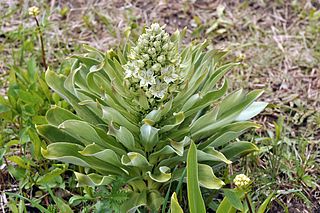
Frasera speciosa is a species of flowering plant in the gentian family (Gentianaceae) known by the common names elkweed, deer's ears, and monument plant.

Leucospermum pedunculatum is an evergreen, low shrub of 15–30 cm (½–1 ft) high spreading from a single stern upright stem, from the family Proteaceae. The powdered or hairless line-shaped to somewhat sickle-shaped leaves are 3–6 cm (1.2–2.4 in) long and 2–5 mm (0.08–0.20 in) wide. The stalked, individually set flower heads are globe-shaped, 2½−3 cm in diameter consist of initially white to pale cream flowers that eventually turn carmine. From the center of the flowers emerge straight styles that jointly give the impression of a pincushion. It is called white-trailing pincushion in English. It flowers from August to January, peaking in September. It is an endemic species that is restricted to a narrow strip on the south coast of the Western Cape province of South Africa.















